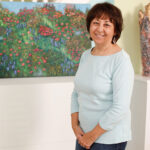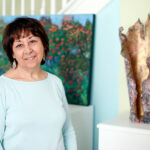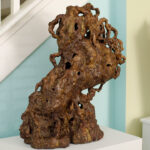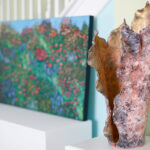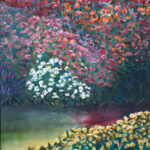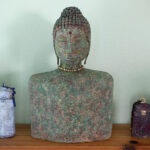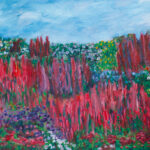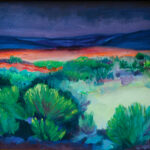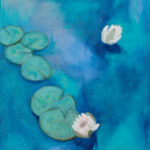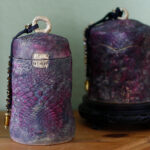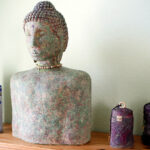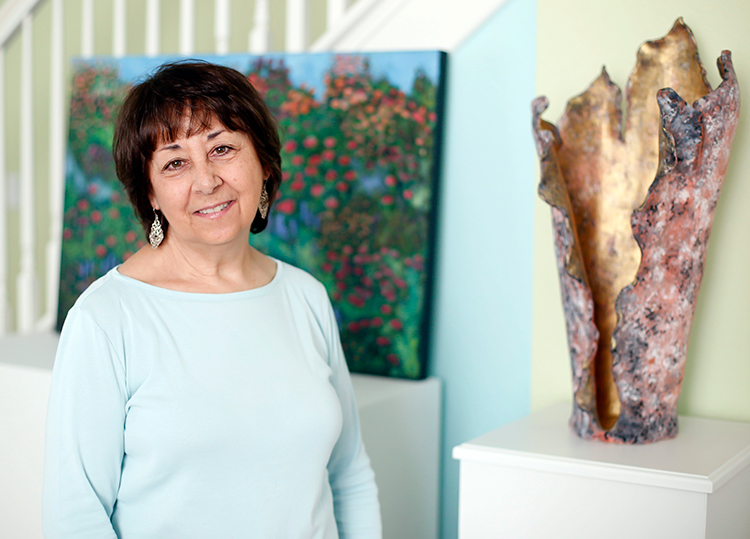
The exhibition of local artist Lisa Lugo, on display through Jan. 28 at the Center for Spiritual Care in Vero Beach, has something for people of many faiths.
“Unity in Diversity,” which opens with a reception at 5 p.m. on Jan. 7, features ceramic sculptures and acrylic paintings whose symbolic subject matter includes the figures of Buddha, Catholic saints and angels, as well as Sacred Hearts, trees of life and eternal flames.
For those whose spiritual feelings can’t be pinned to symbols, there are paintings that may evoke memories of a personal sacred place or space; among them, a desert landscape, fields of flowers and a light-filled cavern.
Perhaps nowhere do so many different symbols come together in Lugo’s work than in her grouped display of ceramic hamsas, hand-shaped plaques that hang against the wall from silken loops of sari material.
Also known as the Hand of Miriam, the hamsa is derived from the Middle Eastern amulet that represents God’s blessing on its possessor. Whether displayed with the fingers held upward, as in the traffic cop’s gesture for “stop,” or with fingers directed toward the earth, all hamsas represent good fortune, says Lugo.
She notes that prints or tracings of the human hand are as old as humankind. As a Native American symbol, the hand has been in use for well over 1,000 years, as evidenced by the petroglyphs of the Western U.S. Essentially, it means, “People were here.” A hand with a spiral etched into the palm is thought to represent the life-giving sun.
Lugo is not interested in merely reproducing the symbolism of other cultures; she creates her own variations on, and combinations of, the symbols she chooses to use.
“Some of (my designs) are just because I felt like it,” she says.
Indicating a hand that she decorated with an iridescent green insect Lugo says, “The dragonfly is also symbolic to some tribes.” She notes that it represents spiritual activity.
Within the hand-shaped form, Lugo has allowed her love of spiritual symbolism to go wild.
One of her hamsas bears an incised line that begins as a spiral and loops like a handwriting exercise, then straightens to reach its terminus at the image of a white lotus. The line is a Buddhist design called an unalome.
Says Lugo, “Buddhists believe that the path to enlightenment is never straight. The unalome represents the path. Of course, the lotus always stands for enlightenment.”
Lugo’s ceramic art works often refer to the flowing symbols and shapes of Buddhism.
One of her major pieces in the show is a 26-inch-high, hollow-built ceramic torso of Buddha.
The closed eyes of the figure suggest profound meditation, and the shape of its torso, with the lightest of lines indicating a garment folded over the breast, is like a great silent bell. The treatment of the surface, a mottled mixture of acrylic paint over fired-on underglazes and oxide washes, gives the torso the appearance of cast bronze.
Lugo says that she likes to finish her sculptures with hand-applied paint, “because I don’t have to fire it, and fire it, and fire it to get the same effect. Every time you fire it, you take a chance of something happening to it.”
That “something” might include an early, low-fire glaze melting off in a later firing that is too hot for it, or a small crack, unseen at first, that grows in subsequent firings, perhaps to split the piece in two.
Calm acceptance of flaws in the process of creation, whether in the making of a ceramic sculpture or the refining of her spiritual life, is in Lugo’s nature.
How did, Lugo, a New Jersey girl born and raised in the Catholic Church, come to create figures of Buddha? Her response is matter of fact.
“I’ve always had an interest in spirituality. That there is something greater than just us,” she says.
Concerning Buddhism, she adds, “It isn’t really a religion, technically. It is a philosophy with morals. You can be Catholic and still practice Buddhism. My friend Melody is Jewish, and she practices Buddhism. It’s a way of life.”
When asked if, today, she is Catholic, a Buddhist, or both, Lugo simply replies, “A Christian.”
“The santos are Christian,” she says.
She refers to several small ceramic figures in her show whose torsos are inspired by the carved wood figures of saints that were created in Spain and its colonies in the Americas. In Lugo’s recreation of the female santos form, the lower half of the figures is composed of a ceramic representation of the cage-like wooden support that, in some versions of the saintly form, was meant to be clad in the richest fabric skirting the owner could afford. A metal and glass rosary is twined around the neck of each of Lugo’s santos.
Lugo says that santos were originally used by farm folk who lived far from the nearest town.
“When the weather was inclement, and they couldn’t go to church, they would use the different saints to make their own Mass and prayers around the santos,” she says.
She adds, “Other religions, beside Catholicism, also have saints that they believe in and honor.”
Unlike the Catholic Church, in which saints are identified in a formal process and officially sanctioned by the pope, religions that include Islam, Shintoism, Judaism and Buddhism designate sainthood by popular acclaim. Saints in those religions accomplish much the same things as their Catholic counterparts. They intervene in human lives for good, impart spiritual insight to those who seek it, and sometimes perform miracles.
While ceramic art is Lugo’s first love, when she wishes to describe the indescribable, she takes leave of the earth – as in her supply of clay – and picks up her paint brush.
Her 30-inch-high, 24-inch-wide painting “Liberation” envisions a woman in a blue gown floating in the blue. Whether the color represents air or water is up to the viewer’s fancy. The woman’s eyes are closed, and her expression is neutral. In contrast to her passive yet weightless body, the woman’s hair fans out around her shoulders in Medusa-like tendrils. Is the woman dead, or is she in a meditative trance? Is she imaging herself being seen by us, or is she a spirit, unaware of herself and her viewers?
Lugo thinks that what she titles her paintings is important to her and to the viewer, for whom the title is an introduction to the painting and, through the painting, to her.
“I love trying to connect my thoughts about the work to my viewers,” she says.
In a statement that she wrote about “Liberation” she says, “Liberation could be just as easily heaven or nirvana. It is really just another way of describing a stage of being where one is free.
Free from emotional pain, physical pain, the horrors of the world. Pure bliss.”
Several of the most engaging paintings in the exhibition are of flower gardens, three of which were inspired by the poetry of the 13th century Persian polymath, Jalāl ad-Dīn Mohammad Rūmī. “Rumi’s Garden,” the first painting so inspired, owes its final form to a poem by Rumi that begins, “Out beyond ideas wrongdoing and right doing, there is a field. I’ll meet you there.”
“On that one I wanted to refer to a meeting of the minds, and how much we need that, politically, culturally, environmentally,” she says.
For her, that is what Unity in Diversity is all about.
Her exhibition at the Center for Spiritual Care continues through Jan. 28. Phone 772-567-1233 for an appointment to view the show.
Photos by Kaila Jones


